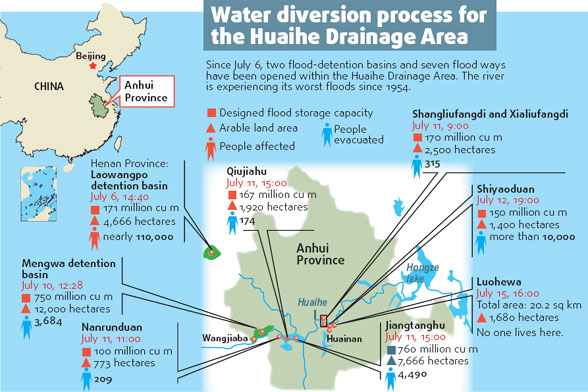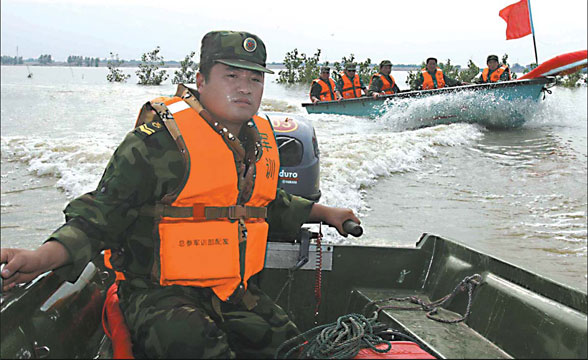Floods wash away crops, but not hope
By Wang Zhenghua (China Daily)Updated: 2007-07-18 07:04
Fearing their decades-old house might collapse any minute under the pressure caused by the unexpected downpour, the woman holds her months-old granddaughter in arms, seeking shelter under an umbrella outside their leaking home.
"I saw my grandchild, who was shivering in the cold, firmly clutching the handle of the umbrella to secure some sense of safety. The scene totally broke my heart," sobs the 52-year-old woman.
The worst flooding since 1954 on the bulging Huaihe River is still ravaging millions of households like the Chens at the river's watersheds in four provinces of Henan, Anhui, Jiangsu, and Shandong.
By Monday, a total of 20.4 million residents had been affected since heavy rains began to hit the region hard early this month. More than 12 billion yuan ($1.6 billion) in economic losses have been reported, with tens of thousands of houses collapsed and millions of hectares of crops damaged.
At Chen's house, flood waters have left distinct soak marks almost everywhere. Over the bed, shrouded in the messy mosquito net, a huge sheet of plastic is placed to scoop the leaking rainfall.
The barely furnished room of 15 square meters is soaked in mud water. The brick house, divided into two by a mud wall, is dim, stuffy and covered by mold.
"When the downpour started, we had to use every basin and pot to divert the water out of house," Chen's sister-in-law, says.
But she says that their houses, though vulnerable in the heavy rainfall and wind, were strong enough to withstand floods.
Tens of thousands of families in the northwestern part of East China's Anhui Province live in houses built on elevated platforms that divide Huaihe River and the buffer zones, used to divert the rising waters.
But the swollen river has overflowed the embankments, with the 100-meter-wide crop field between the high platform and far-spreading river embankment submerged in muddy waters.
The original stream was hardly recognizable yesterday, with flood water reaching the crowns of trees.
One of the biggest problems facing poverty-stricken families, is that the ferocious floods have cut them off from provisions.
At Chen's home, almost no crops could be harvested this year.
"The flour, harvested before the flood and left last year, can barely feed us till the end of the year," Chen says.
"The chance of replanting is pretty dim and too late. I am wondering if my husband and I should join my children and make a living in relatively developed eastern cities."
In Anhui, an agricultural province, many young people head to the cities to try and make a living.
These farmers-turned-workers, earning much higher than their rural peers on the land, could provide some relief to their impoverished families.
Li Ling's husband is one of many migrant workers from Laoguan Village in the southern part of Funan. He is employed by a construction team in the coastal city of Ningbo.
Li, 32, is left home to take care of their three kids.
"When the heavy falls hit hard our village, the water in the house was so deep it reached my lower legs," Li recalls.
One week ago, she and tens of thousands of families were relocated from the Mengwa Buffer Zone, as a key hydrological station on the river released water.
Losing her small plot of crops in the flooded buffer zone, Li and her three children, the eldest 9 and the youngest 7, have to make do with the grain left over from last year.
"I haven't bought any meat for two months," says an upbeat Li, who is still waiting for compensation for losses caused by water diversion in the buffer zone.
Ding Jinli, the interim Party branch set up in Laoguan Village to direct disaster relief, says food and accommodation of each family was guaranteed and that no outbreaks of disease had been reported.
Ding is one of a number of cadres sent from the county to assist with relief efforts.
"We have deployed 30 workers for every kilometer along the bank," Ding says.
"It's the worst flood of Huaihe I have ever seen. But I am sure we will overcome the difficulties."
 |
|
||
|
||
|
|

